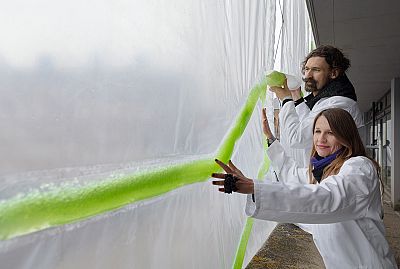Draped over buildings, the living walls scrub carbon dioxide from the air while pumping out oxygen.
Air pollution is an enormous problem in many urban areas, but two European architects have developed plant-filled plastic curtains designed to turn building facades into "living walls" that help purify dirty air.
The curtains contain a mazelike network of tubes filled with microscopic algae, which like all green plants remove carbon dioxide from the air while pumping out oxygen via the carbon-sequestering process known as photosynthesis. Air flows into the bottom of the curtains and rises through the tubes, feeding the microalgae along the way.
Science
"Microalgae have exceptional properties that have been discovered by biologists that allow them to re-metabolize some of the waste that our city generates," said Claudia Pasquero, an architect with the London-based firm EcoLogicStudio and one of the developers of the algae curtains. "What we've done is try to understand how we can integrate microalgae in the urban environment."
Pasquero and her partner on the project, Marco Poletto, said they foresee a strong market for the eco-friendly curtains, especially for use on warehouses and other large buildings valued more for their function than their appearance. They said the curtains might sell for $350 a square meter, though they didn't specify when a commercial version of their prototype curtains might be commercially available.
Last month, the architects displayed an early prototype of the curtains in Ireland, covering the first and second floors of Dublin Castle with more than a dozen of the drapes. Collectively, the curtains used to cover the castle can suck more than two pounds of carbon dioxide from the air each day, according to the architects. That's roughly the amount removed each day by 20 large trees, they said.
It's an impressive claim, but not everyone is convinced.
"I appreciate the architects thinking outside the box, but this approach seems more of a gimmick than a real solution," Gaboury Benoit, a professor of environmental chemistry at Yale, told NBC News MACH in an email.
Even if the curtains are effective at removing some carbon dioxide from the air, Benoit said, they don't provide shade, as trees do. And unlike the drapes, which the architects said would need to be reconditioned every two to three years, trees are naturally self-replenishing.
"I'd say trees do it better, unless detailed study shows me otherwise," Benoit said.
But Poletto said the curtains could be designed to offer a bit of shade to building interiors, adding that they could be used in regions where extreme cold limits the growth of trees as well as in urban spaces where there simply isn't anywhere to plant them.
One thing that's not in doubt is the need to find new ways to rid the atmosphere of excess CO2. A recent U.N. report on climate change warned that the world must take "unprecedented" action to save our warming planet — and it included a call for new approaches to carbon sequestration.
Poletto said he and Pasquero were inspired to develop the eco-friendly curtains after noticing an abundance of algae in ponds near their office.
"As we collaborated with microbiologists and learned more and more about the algae's potential, it became kind of an obsession," he said, adding that he and Pasquero were eager to find an aesthetically pleasing way to harness the algae's CO2-sucking prowess.
"For us, the aspect of design is really essential," Pasquero said, "so it's not simply a technological innovation — it's a design solution."












